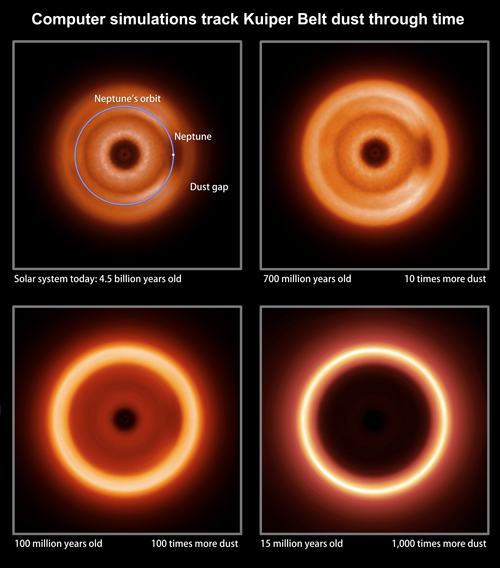Please note: Osher Rainforest will be closed for maintenance May 7-9.
Science News
Alien’s-Eye View of the Solar System?
September 23, 2010
0

We’ve found nearly 500 planets around others stars (maybe more by the time you read this, but you can check NASA’s PlanetQuest site to confirm), but how would an alien civilization find us?
According to an announcement today from NASA:
New supercomputer simulations tracking the interactions of thousands of dust grains show what the solar system might look like to alien astronomers searching for planets. The models also provide a glimpse of how this view might have changed as our planetary system matured.
Or, as noted in the “Geeked on Goddard” blog:
And maybe, just maybe, by imaging those rings, gaps, and clumps in disks of dust around alien star systems, we might be able to discover planets. In other words, we might find planets by spotting their gravitational pull on their surroundings, as opposed to taking a picture of the actual planets, which is a rare and delicate trick.
So an alien astronomer might spot a gap in the rings of dust around the Sun rather than detecting a planet directly. The Hubble Space Telescope observed just such a disk around the bright star Fomalhaut, as announced in 2008, and presumably sophisticated astronomers on distant planets could make a similar observation of our solar system.
Anyway, that supercomputer stuff was transformed into a spiffy computer animation. You can watch the clip at, um, less-than-ideal YouTube resolution, but why settle for that? NASA Goddard’s Science Visualization Studio offers high-resolution versions of the video for download. Enjoy those extra pixels! (And better compression algorithms.)
The production team here at the Visualization Studio was particularly pleased with the NASA animation because it looks a lot like what we’re depicting in our upcoming new show, “Life: A Cosmic Story,” which opens on November 6 of this year (read the press release if you’re interested). It also bears a more than passing resemblance to the disk we created for the “Citizen Sky” trailer we announced earlier this year.
An intriguing perspective on ourselves… From an alien point of view!
Ryan Wyatt, Director
Morrison Planetarium and Science Visualization
0